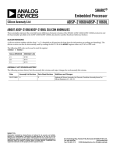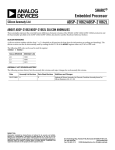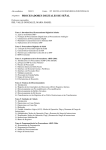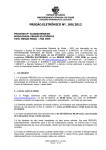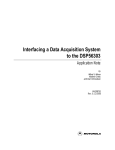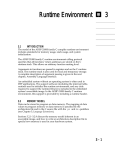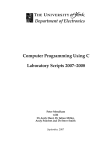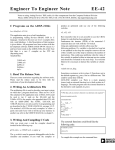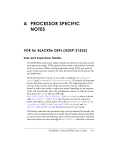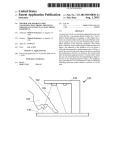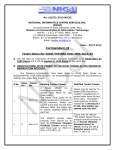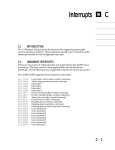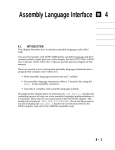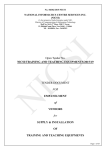Download Silicon Anomaly List for SHARC ADSP-21061
Transcript
SHARC® Embedded Processor ADSP-21061/ADSP-21061L a Silicon Anomaly List ABOUT ADSP-21061/ADSP-21061L SILICON ANOMALIES These anomalies represent the currently known differences between revisions of the SHARC ADSP-21061/ADSP-21061L product(s) and the functionality specified in the ADSP-21061/ADSP-21061L data sheet(s) and the Hardware Reference book(s). SILICON REVISIONS A silicon revision number with the form "- x.x" is branded on all parts(see the data sheet for information on reading part branding). The silicon revision can also be electronically read by reading the bits 31-28of the MODE2 register either via JTAG or DSP code. The following DSP code can be used to read the register: <UREG> = MODE2; Silicon REVISION MODE2[31:28] 0.1 1101 ANOMALY LIST REVISION HISTORY The following revision history lists the anomaly list revisions and major changes for each anomaly list revision. Date Anomaly List Revision Data Sheet Revision Additions and Changes 02/07/2008 A C Update of Silicon Anomaly List Format NR003718A Information furnished by Analog Devices is believed to be accurate and reliable. However, no responsibility is assumed by Analog Devices for its use, nor for any infringements of patents or other rights of third parties that may result from its use. Specifications subject to change without notice. No license is granted by implication or otherwise under any patent or patent rights of Analog Devices. Trademarks and registered trademarks are the property of their respective owners. One Technology Way, P.O.Box 9106, Norwood, MA 02062-9106 U.S.A. Tel: 781.329.4700 www.analog.com Fax: 781.461.3113 ©2008 Analog Devices, Inc. All rights reserved. ADSP-21061/ADSP-21061L Silicon Anomaly List SUMMARY OF SILICON ANOMALIES The following table provides a summary of ADSP-21061/ADSP-21061L anomalies and the applicable silicon revision(s) for each anomaly. No. ID Description 0.1 1 14000002 DAG2 BITREV() modify instruction with non-zero modify x 2 14000003 Hold Time Cycle Wait State and MSx pins x 3 14000004 CJUMP instruction with alternate I4-I7 x 4 14000006 Host Bus Grant not returned if ID=0 and CS=1 x 5 14000007 Core external hold waitstate blocking of IOP access of EP x 6 14000008 Sport RFS with LFS mode deasserts early x 7 14000010 DMA to Broadcast Memory Space x 8 14000011 Data format specification for Sport Multichannel mode x 9 14000012 Sport Transmit Underflow Status is not available for Multichannel mode x 10 14000013 Host write failure in a multiprocessing system x 11 14000014 Branch with ELSE instruction preceded by a held EP access x 12 14000015 ACK during PROM Boot x 13 14000016 BRx incorrectly asserted during DAG stalls x 14 14000017 Glitch Rejection Circuits not applicable to currently shipping ADSP-2106x products x 15 14000019 Short word accesses (read or write) fail when following any stalled instruction x 16 14000021 Rn=MANT Fx results will be rounded if RND32 is enabled x 17 14000022 Execution of instructions that modify interrupt latch registers may cause incoming interrupts to be ignored x 18 14000023 DMA Request max queue depth of 6 x 19 14000026 Sport Transmit Underflow Status is incorrect when Sport generates TFS x 20 14000063 Restrictions in operation of ADSP-21061-200 at 50MHz x Key: x = anomaly exists in revision . = Not applicable NR003718A | Page 2 of 12 | February 2008 ADSP-21061/ADSP-21061L Silicon Anomaly List DETAILED LIST OF SILICON ANOMALIES The following list details all known silicon anomalies for the ADSP-21061/ADSP-21061L including a description, workaround, and identification of applicable silicon revisions. 1. 14000002 - DAG2 BITREV() modify instruction with non-zero modify: DESCRIPTION: The BITREV(Ic,<data24>) modify instruction where Ic is a DAG2 register and <data24> is a 24 bit modify constant behaves as if <data24>=0. Bit reversed indirect addressing mode (using I0 or I8) works properly. The BITREV(Ia,<data32>) modify instruction, where la is a DAG register, also works properly. WORKAROUND: Replace BITREV(Ic,<data24>); With MODIFY(Ic,<data24>); BITREV(Ic,0); APPLIES TO REVISION(S): 0.1 2. 14000003 - Hold Time Cycle Wait State and MSx pins: DESCRIPTION: Programmed wait states of 4,5,6 should automatically generate a hold time cycle for any read or write (pg. 5-36 to 5-40 of SHARC Users manual). This means that the address, MSx, and data buses keep driving for 1 cycle after the RD or WR goes high. A problem occurs if the RD or WR access is followed by a dead cycle (an internal access) on the external bus. The MSx lines are not held low during the hold cycle and are brought high as if the hold cycle was not programmed. The Address and Data buses are still properly held in this case, only the MSx is prematurely deasserted. WORKAROUND: If the hold time is needed, place a dummy external read or write after the access like this: jump (pc,3) (db);/*delayed branch to make next 2 instructions non-interruptable*/ dm(hold_expected_address)=r0;/*this read or write requires a hold time cycle*/ r1=dm(dummy_ext_address); /*dummy ext RD or WR ensures the MSx will obey hold time*/ This ensures that a memory cycle will occur after the DM transfer and that the MSx line will be low during the hold time cycle. The dummy access can be a read or a write. This works even if a HBR causes a BTC (Bus Transition Cycle) and breaks up the two external accesses. APPLIES TO REVISION(S): 0.1 NR003718A | Page 3 of 12 | February 2008 ADSP-21061/ADSP-21061L Silicon Anomaly List 3. 14000004 - CJUMP instruction with alternate I4-I7: DESCRIPTION: If the alternate I0-I3 registers are enabled and the normal I4-I7 register are enabled and a CJUMP instruction is executed, then the CJUMP instruction will incorrectly use the alternate I6 and I7 instead of the normal set for the I6=I7 function of CJUMP. CJUMP is normally used only by the C compiler for function calls and since the C compiler does not split the normal and alternate DAG registers this is not a problem. WORKAROUND: When a CJUMP is executed, always have the I0-I7 registers all normal or all alternate. APPLIES TO REVISION(S): 0.1 4. 14000006 - Host Bus Grant not returned if ID=0 and CS=1: DESCRIPTION: If HBR is asserted and the processor ID is 0, and the CS pin is deasserted, then, HBG will not be asserted. WORKAROUND: Change the ID to 1 and pull up or tie high BR2-BR6. APPLIES TO REVISION(S): 0.1 5. 14000007 - Core external hold waitstate blocking of IOP access of EP: DESCRIPTION: If the SYSTAT EBPR (external bus priority) is set to even priority, and the core continuously accesses an external address which is programmed for 4, 5 or 6 wait states (i.e., a hold cycle is enabled), then any IOP access of the external port will be blocked. The potential IOP accesses of the external port are "master mode", "paced master mode" , "handshake mode", and "external handshake mode" DMAs. WORKAROUND: If this situation can occur, set EBPR to "core priority" or "I/O processor priority". APPLIES TO REVISION(S): 0.1 6. 14000008 - Sport RFS with LFS mode deasserts early: DESCRIPTION: An internally generated RFS will deassert 1/2 RCLK cycle early if LAFS=1 (Late Frame Sync).For connection to other SHARCs this is not a problem because only the asserting edge of the frame sync is sampled on the transmit side. WORKAROUND: None APPLIES TO REVISION(S): 0.1 NR003718A | Page 4 of 12 | February 2008 ADSP-21061/ADSP-21061L Silicon Anomaly List 7. 14000010 - DMA to Broadcast Memory Space: DESCRIPTION: DMA transfers where the destination is set to Broadcast Memory Space can cause the Master SHARC's external port to hang, specifically the master does not pre-charge ACK. Core driven transfers to Broadcast Memory Space do not cause this problem. WORKAROUND: If data needs to be sent to all processors either use the core to perform the transfers or perform separate DMA transfers to each processor. APPLIES TO REVISION(S): 0.1 8. 14000011 - Data format specification for Sport Multichannel mode: DESCRIPTION: For multichannel operation, the companding selection and MSB-fill sections are not independent as indicated in the SHARC Users Manual. The DTYPE bits in the STCTLx and SRCTLx registers select the data format in this mode as follows: If companding is selected on a channel: DTYPE Data Formatting x0 Compand using u-law; Right justify, sign-extend into unused MSBs x1 Compand using A-law; Right justify, sign-extend into unused MSBs If companding is not selected on a channel: DTYPE Data Formatting x0 Right justify, zero-fill into unused MSBs x1 Right justify, sign-extend into unused MSBs WORKAROUND: None APPLIES TO REVISION(S): 0.1 9. 14000012 - Sport Transmit Underflow Status is not available for Multichannel mode: DESCRIPTION: The Transmit Underflow Status, TUVF bit in the STCTLx register, does not provide valid information in Sport Multichannel mode. This status bit should not be used in this mode. WORKAROUND: None APPLIES TO REVISION(S): 0.1 NR003718A | Page 5 of 12 | February 2008 ADSP-21061/ADSP-21061L Silicon Anomaly List 10. 14000013 - Host write failure in a multiprocessing system: DESCRIPTION: Data from an asynchronous host write will be written to the wrong location under the following scenario: a) A master SHARC writes data into the internal memory or EP (External Port) buffer of a slave SHARC such that the Direct Write FIFO or an EP Buffer (6 deep) fills up and data backs up into the Slave Write FIFO (2 deep ) of a slave SHARC., b) A host performs an asynchronous write. Under this scenario, the host data is written to the Direct Write FIFO if the master SHARC had been performing direct writes to memory, or the data will be written to the EP Buffer to which that master SHARC had been writing. WORKAROUND: Workaround 1: Once the host gains bus mastership, it should perform a read of either an IOP location or memory before it performs any writes. The read will force the backed up writes to complete, thus removing the condition that causes this problem. Workaround 2: Assure that data never backs up into the Slave Write FIFO through software control. APPLIES TO REVISION(S): 0.1 11. 14000014 - Branch with ELSE instruction preceded by a held EP access: DESCRIPTION: If an instruction type 9, 10 or 11 using the ELSE option is preceded by a held off EP (External Port) access, the held off access will not complete correctly (RD or WR is not asserted). The following is an example instruction combination which may result in the anomalous behavior: a) R5 = dm(0x4000234); /* held off external port access*/ b) IF EQ jump (pc,5), ELSE R3=R1+R2; /* example instruction type 9,10 or 11 */ The external port access will be held off if any of the following conditions are true: a) The processor is not the bus master or the bus is granted to the host. b) SBTS is asserted. WORKAROUND: Workaround 1: Place a NOP or other instruction with no EP access before the type 9, 10 or 11 instruction using the ELSE option (between line A and B in above example). To avoid the anomalous behavior, the destination of a delayed branch cannot be an instruction of type 9, 10 or 11 if the second slot of the delayed branch contains an EP access. (RTI instructions can only be avoided by disabling interrupts, thus an RTI db(Delayed Branch) with an EP access in the second delay slot can never be guaranteed to not precede an instruction of type 9, 10 or 11 which uses the ELSE.) Workaround 2: Do not use Branch with ELSE instruction if core external accesses can occur while the bus is granted to a host or another SHARC. APPLIES TO REVISION(S): 0.1 NR003718A | Page 6 of 12 | February 2008 ADSP-21061/ADSP-21061L Silicon Anomaly List 12. 14000015 - ACK during PROM Boot: DESCRIPTION: In a multiprocessor system which uses PROM boot mode, a situation can occur in which ACK is driven low by a slave. This can cause PROM reads to hang. The situation is as follows:, a) ID1 access of a slave's MMS (Multiprocessor Memory Space) address range is followed by a RESET cycle with no power cycling. b) After the RESET is deasserted, ID1 will drive the MMS address of the slave previously accessed for 4 CLKIN cycles. Then ID1 will drive address 0x400000 and the PROM boot DMA will begin. c) Normally the ACK line is pulled high by ID1 and kept high by the keeper latch in the bus master. d) When the slave sees its MMS address, it drives ACK low. ACK is kept low by the keeper latch and the subsequent PROM boot DMA read will hang waiting for ACK. WORKAROUND: Workaround 1: Drive ACK high with an tristate driver when BMS is asserted low. Tristate this driver when BMS is high. Workaround 2: Apply reset twice with at least 4 CLKIN cycles between them. This allows the PROM boot DMA address to replace the slave MMS address in ID1's address output latch. APPLIES TO REVISION(S): 0.1 13. 14000016 - BRx incorrectly asserted during DAG stalls: DESCRIPTION: As documented on page 4-12 of the ADSP-2106x SHARC User's Manual [page 4-16 of the ADSP- 21065L SHARC User's Manual] certain instruction sequences involving data transfers to and from DAG registers will cause the insertion of a stall for a single processor cycle. An anomalous behavior occurs when such a stall cycle is caused by an indirect memory access to internal memory immediately following a register write in the same DAG (as shown below). During the stall cycle, the processor incorrectly assumes an external memory access and asserts the BRx line associated with its ID. (This occurs regardless of processor ID.) The instruction sequence will function correctly but this can potentially induce a BTC (Bus Transition Cycle), which may reduce bandwidth on the external cluster bus. (Note: the compiler can generate such code.) L2= @buffer; // inst1 r0= DM(M4,I4); // inst2: I4 points to internal memory WORKAROUND: Insert an instruction that does not employ the stalled DAG (for example, nop; ) between the instruction modifying the DAG register (inst1) and the instruction indirectly accessing memory (inst2), as follows: L2= @buffer; // inst1 NOP; // workaround r0= DM(M4,I4); // inst2 APPLIES TO REVISION(S): 0.1 NR003718A | Page 7 of 12 | February 2008 ADSP-21061/ADSP-21061L Silicon Anomaly List 14. 14000017 - Glitch Rejection Circuits not applicable to currently shipping ADSP-2106x products: DESCRIPTION: Section 11.4.1 Glitch Rejection Circuits on page 11-17 of the ADSP-2106x SHARC User's Manual is not applicable to the currently shipping ADSP-2106x products. All critical signal lines such as CLKIN, RD, WR, DMAR,, RCLKs, and TCLKs should carefully laid out to eliminate glitches. Section 11.4.2 Link Port Input Filter Circuits on page 11-17 of the ADSP-2106x SHARC User's Manual is not applicable to the currently shipping ADSP-2106x products. Link port data and clock lines should carefully laid out to eliminate glitches. WORKAROUND: None APPLIES TO REVISION(S): 0.1 NR003718A | Page 8 of 12 | February 2008 ADSP-21061/ADSP-21061L Silicon Anomaly List 15. 14000019 - Short word accesses (read or write) fail when following any stalled instruction: DESCRIPTION: Any access (read or write) to short-word memory space can fail if it follows a stalled instruction or causes an instruction stall (see below for examples). A DMA process cannot cause this anomaly. It is restricted to conditions set up in the core processor. Also a DMA process will not be impacted by this anomaly i.e. the DMA will function correctly even if the anomaly occurs. Note: The occurrence of the failure will vary with temperature, voltage, and frequency. An instruction can stall due to the following circumstances: 1) DAG Stall: An instruction that loads a DAG register followed by an instruction that uses the same DAG for a memory access will cause the second instruction to stall.Ex: L2= 8; DM(I0, M0) = R1; // Both L2 and I0 reside in DAG1 causing this instruction to stall Failure can occur if I0 points short word space or if the above instruction sequence is followed by a short word access. See the ADSP2106x SHARC User's Manual Second Edition Page 4-12, section 4.1.1. 2) PM Memory Data Access (Cache Miss): Any instruction that uses the PM bus to perform a data access will cause an instruction stall the first time it is executed. Ex: PM(I8,M8) = R1; See the ADSP-2106x SHARC User's Manual Second Edition Page 3-38, section 3.10. 3) Memory Block Conflict: If an instruction requires two accesses to the same memory block, the instruction will stall.Ex: DM(I0, M0)=R0, PM (I8,M8) = R1; // a stall will occur when both address pointers point to the same memory block. See the ADSP-2106x SHARC User's Manual Second Edition Page 5-8, section 5.1.5. 4) Wait states for External Memory Accesses: An instruction that contains an external memory access where the waitstate setting for that memory bank is greater than 0 or the access is held off due to the ACK signal or through bus arbitration causes that instruction to stall. See the ADSP-2106x SHARC User's Manual Second Edition Page 5-39, section 5.4.4. 5) Multiple Bus Accesses to IOP Registers in the same IOP Register Group: An instruction may be stalled due to multiple busses trying to access IOP registers in the same group. For this anomaly, the only applicable case is if an external host or processor accesses the same group of registers at the same time as the core.Ex: DM(MSGR0) = R1; // Instruction executed while the host or another processor writes to MSGR2. See the ADSP-2106x SHARC User's Manual Second Edition Page E-8, section E.3.3 6) Executing instructions from external memory with wait states: Any instruction being executed from external memory where the waitstate setting for that memory bank is greater than 0 or the access is held off due to the ACK signal causes that instruction to be stalled. WORKAROUND: For the cases 1 to 5 above, insert a NOP between the stall-able instruction and the Short-word access or remove the stall condition. There is no work around for case 6. Note: Care must be taken when using the delayed branch (DB) option with jumps, calls, and returns to ensure that failing sequence does not occur. For example ensure that the 2 instructions in the RTI (DB) do not cause an instruction stall if returning to code that includes short word accesses. APPLIES TO REVISION(S): 0.1 NR003718A | Page 9 of 12 | February 2008 ADSP-21061/ADSP-21061L Silicon Anomaly List 16. 14000021 - Rn=MANT Fx results will be rounded if RND32 is enabled: DESCRIPTION: The instruction Rn=MANT Fx was designed to work independently of the rounding mode, but it does not. For example, consider the following set of instructions: R2=0x45678901; F1=float R2; R0=mant F1; If rounding is enabled (RND32) the result in R0 would be R0=8ACF120000, but if rounding is not enabled the result would be R0=8ACF120200. WORKAROUND: If the desired result of the MANT instruction is unrounded, but rounding is enabled in the code, the user must disable rounding manually before executing the MANT instruction and then re-enable the instruction after the MANT instruction has been executed. Keep in mind that writes to MODE1 have a 2 cycle effect latency. The workaround implemented for the example presented above would be as follows: Bit CLR MODE1 RND32; R2=0x45678901; F1=float R2; R0=mant F1; Bit SET MODE1 RND32; Nop; APPLIES TO REVISION(S): 0.1 NR003718A | Page 10 of 12 | February 2008 ADSP-21061/ADSP-21061L Silicon Anomaly List 17. 14000022 - Execution of instructions that modify interrupt latch registers may cause incoming interrupts to be ignored: DESCRIPTION: When the execute phase of bit manipulation instruction that modifies an IRPTL (Interrupt Latch Register) is extended due to the core being held off, some of the interrupts that are latched during this period in the interrupt latch register can be lost. The core can be held off when fetching the next instruction from external memory, accessing data from external memory, reading from empty buffer, writing to full buffer or IOP register reads that take more than one core clock cycle. The specific Group IV system register bit manipulation instructions that are affected are as follows: BIT SET IRPTL <data32>; BIT SET IMASKP <data32>; BIT CLR IRPTL <data32>; BIT CLR IMASKP <data32>; BIT TGL IRPTL <data32>; BIT TGL IMASKP <data32>; The interrupts that can be missed are IRQx, EMUI, TMZHI, TMZLI, VIRPT, LPxI, SPIRI, SPITI, EPxI. The LPxI, SPIRI and SPITI interrupts are affected only for DMA driven transfer mode. This failure will occur under any of the following conditions: 1. When the bit manipulation instruction that modifies an interrupt latch register is executed from external memory. 2. When the bit manipulation instruction is executed from internal memory in a delayed branch to a JUMP or CALL to external memory. For example: a) JUMP/CALL ext_mem_location (db); BIT CLR IRPTL <data32>; NOP; b) JUMP/CALL ext_mem_location (db); NOP; BIT CLR IRPTL <data32>; 3. When the bit manipulation instruction is executed from internal memory and it immediately followed by an external memory data access. For example: a) BIT CLR IRPTL <data32>; dm(ext_mem) = r0; b) BIT CLR IRPTL <data32>; pm(ext_mem) = r0; c) BIT CLR IRPTL <data32>; r0 = dm(ext_mem); d) BIT CLR IRPTL <data32>; r0 = pm(ext_mem); 4. When the bit manipulation instruction is executed from the emulator (running or stepping.) WORKAROUND: 1. The workaround for condition 1 is to place the bit manipulation operation in internal memory. 2. The workaround for condition 2 is to avoid the bit manipulation instruction from being within the delayed branch of a JUMP or CALL to external memory by placing it before the JUMP or CALL to external memory. 3. The workaround for condition 3 is to place a NOP; instruction directly following the bit manipulation instruction. 4. A compiler workaround for this issue will be available in a tools patch slated for June 2003. APPLIES TO REVISION(S): 0.1 NR003718A | Page 11 of 12 | February 2008 ADSP-21061/ADSP-21061L Silicon Anomaly List 18. 14000023 - DMA Request max queue depth of 6: DESCRIPTION: Documentation note: The DMA Request Counter can hold a maximum of 6 requests, not 7 as previously documented. Queuing up more than 6 requests will cause unpredictable results. WORKAROUND: None APPLIES TO REVISION(S): 0.1 19. 14000026 - Sport Transmit Underflow Status is incorrect when Sport generates TFS: DESCRIPTION: Documentation note: If the transmitting sport generates TFS using late frame sync mode (ITFS, LAFS = 1 in STCTLx register) and data independent transmit frame sync is not selected (DITFS = 0 in STCTLx register), the transmitter will not underflow. However the Sport Underflow Status bit (TUVF) in the STCTLx register can be set incorrectly under these conditions. This status bit should be ignored in this mode. WORKAROUND: None APPLIES TO REVISION(S): 0.1 20. 14000063 - Restrictions in operation of ADSP-21061-200 at 50MHz: DESCRIPTION: When the ADSP-21061-200 is operated with a CLKIN above 40MHz and up to 50MHz the following two functional restrictions apply to external memory accesses: 1) Hold Time Cycle: For an external memory access no hold time cycle is inserted when the wait state count, WAIT (EBxWS)=4,5 or 6 and the wait mode, WAIT(EBxWM)=0 or 3. Hold time cycles will be inserted for WAIT(EBxWS)=4,5 or 6 if the wait mode is set to WAIT(EBxWM)=1 or 2. 2) Page Idle Cycle: No page idle cycle is inserted when WAIT(PAGEIS)=1. WORKAROUND: None APPLIES TO REVISION(S): 0.1 ©2008 Analog Devices, Inc. All rights reserved. Trademarks and registered trademarks are the property of their respective owners. a NR003718A | Page 12 of 12 | February 2008 www.analog.com












